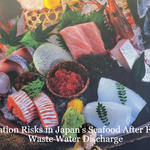| |
| |
|
The 411 for Water Treatment Professionals
|
|
|
|
|
| |
| |
| |
|
Researchers Are Using Beer Wastewater to Develop Biofuels
|

Plastic, cow poop, beer wastewater — you name it, and researchers are working with it to create alternative biofuel products. Biofuel is a fuel derived directly from living matter, and is being used more and more to potentially replace fossil fuels. Researchers at the University of San Diego in California are developing an unlikely mixture to help power the future. “In a sense, I feel like it’s a mix of your kitchen science and sort of, your science lab science,” said Odesma Dalrymple, Ph.D, a professor and researcher at the University of San Diego.
|
|
| |
|
Contamination Risks in Japan's Seafood After Fukushima Waste Water Discharge
|

Experts from Hong Kong have warned that shellfish, oysters, and large fish caught off the coast of Japan may still be at risk of contamination despite the treatment of waste water from the Fukushima Daiichi power plant. The Japanese Consul General, Kenichi Okada, expressed concerns about the potential damage to Hong Kong’s reputation if a seafood import ban were to be imposed in response to the discharge plan. Hong Kong, Macau, and mainland China are among the few places that have already imposed restrictions.
|
|
| |
|
|
| |
| |
| |
|
Here’s How Wastewater Facilities Could Tackle Food Waste, Generate Energy and Slash Emissions
|
Most Australian food waste ends up in landfill. Rotting in the absence of oxygen produces methane, a potent greenhouse gas. While some facilities capture this “landfill gas” to produce energy, or burn it off to release carbon dioxide instead, it’s a major contributor to climate change. Valuable resources such as water and nutrients are also wasted. Composting food waste is the most common alternative. In the presence of oxygen, microbes break down food and garden organics without producing methane.
|
|
| |
|
Mussel-Inspired Membrane Can Boost Sustainability and Add Value to Industrial Wastewater Treatment
|
Engineers have developed a new kind of membrane that separates chemicals within wastewater so effectively that they can be reused, presenting a new opportunity for industries to improve sustainability, while extracting valuable by-products and chemicals from wastewater. Created for use in wastewater treatment, the thin-film composite nanoporous membrane known as a TFC NPM, exhibits an ‘unprecedented’ capability to separate salts and other chemical components from water, and could lead to more sustainable treatment and management of water in a range of industries.
|
|
| |
|
|
| |
| |
| |
|
Keeping Water-Treatment Membranes From Fouling Out
|
When you use a membrane for water treatment, junk builds up on the membrane surface—a process called fouling—which makes the treatment less efficient. In a new study, published in the Journal of Membrane Science, researchers studied how membranes are fouled by interactions between natural organic matter and positively charged ions (such as calcium cations) that are commonly found in water from dissolved minerals and salts.
|
|
| |
|
Bipartisan Infrastructure Law Helping State Fund Water Treatment
|
Gov. Tony Evers, together with the Wisconsin Department of Natural Resources (DNR), recently announced new funding available to help communities address per- and poly-fluoroalkyl substances (PFAS) contamination in wastewater. The funds are made available to Wisconsin through the Bipartisan Infrastructure Law. “This new funding is a continuation of our efforts since 2019 to help make sure all Wisconsinites can trust that the water coming from their tap is safe."
|
|
| |
|
|
| |
| |
| |
|
How Dissolved Oxygen Sensors are Revolutionizing Wastewater Treatment and Monitoring
|
The revolutionary impact of dissolved oxygen sensors on wastewater treatment and monitoring is a testament to the power of technological innovation in addressing environmental challenges. These sensors, which measure the amount of oxygen dissolved in water, are transforming the way we manage and monitor wastewater, leading to more efficient treatment processes and improved environmental outcomes.
|
|
| |
|
Cold Spring Opens Only Water Treatment Facility in Minnesota Using Bacteria to Control Nitrates
|
Commonly found in fertilizer and manure used on farms, the city is one of the hundreds in Minnesota, estimated by Public Works Director Jon Stueve, that struggle to keep the chemical in check. Some wells registered 14 milligrams per liter of nitrate, above federal standards. The new system can bring levels to zero but is set right now to be about five. Stueve says there are a couple of options when limiting nitrates and explains why bacteria made the most sense for Cold Spring.
|
|
| |
|
|
| |
|
|